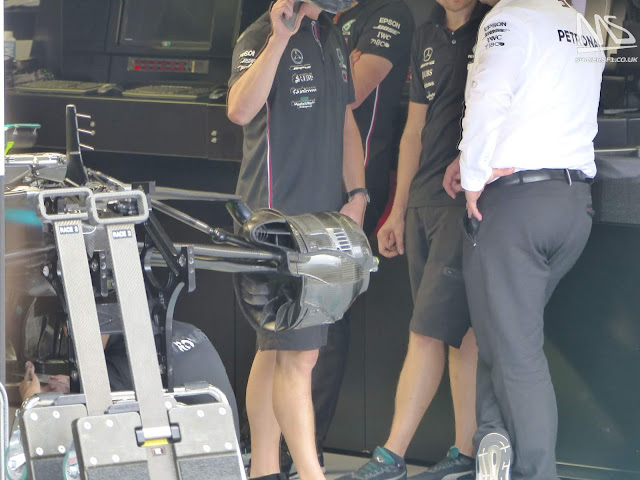Well, I decided to continue my voyage through Europe and having left Spa in my rear view mirror I headed for Cologne and the Michael Schumacher exhibition at Motorworld. Then I moved onto the Technik museums in Speyer and Sinsheim, before rounding out the German leg of the tour at the Mercedes museum in Stuttgart (I'll have features on all of these once I return home and can get through the images and footage).
Stuttgart was the turning point though, did I head home or carry on my road trip? Well, everyone I spoke to told me I'd be an idiot for not making my way to Monza and so, I have. Today I ventured to the public pitlane walk, as I did in
Spa and took plenty of images. None, I'm afraid, of the Ferrari though, as I simply couldn't get near the place - for obvious reasons.
 |
| Williams front suspension and brake duct. Note how the team place a panel panel above the brake disc with gills in it, in order to reject heat created under braking. |
 |
| Their belleville springed heave damper |
 |
| This close-up shows that the crossover is still an active aerodynamic solution for Monza, with airflow taken in by the inlet shot across the face of the drum to mix with and clean up the turbulence created by the wheel rim and tyre. |
 |
| This angle shows off how the bargeboard is connected to the under chassis vane |
 |
| This angle shows just how large the front upright extensionon the FW42 is |
 |
| Toro Rosso's new front wing design for Monza not only looks to reduce front-end load by trimming back the upper flap, but also the shape of the Y250 vortex, as all of the inboard geometries have been altered - The mainplane shape, along with the centreline slot are different, whilst the curvature of the upper three flaps at their tip are totally different. |
 |
| Toro Rosso with a crossover pipe that also allows the airflow to mix with the air that circulates between the drums surface and the wheel rim. |
 |
| Work was being carried out by the Alfa mechanics on the front-end as I passed by their garage |
 |
| The recently updated front wing at Sauber - note how the footplate has been divided into two distinct channels (this division is altered depending on the cicuit characteristics, with it sometimes set back from the leading edge a little). Also note how the footplate gradually tapers off, whilst the endplates outward kick correlates with this. |
 |
| Another close-up of the Toro Rosso front brake assembly, note how the team have small, high angle, winglets on the inboard face of the brake fence. Also note how the team have cleverly incorporated multiple inlets to drive airflow into the desired locations. |
 |
| The new nose, as introduced by Racing Point in Belgium, features a more
conventional thumb tip extension to meet with the FIA's dimensional
criteria and elongated wing pillars which have three slots within. |
 |
| McLaren have perhaps one of the most complicated nose solutions on the grid now, with multiple inlets driving airflow through the centre of the car. Their front wing also features a myriad of complex geometries all designed to maximise the various roles that it must cover under these new regulations. |
 |
| McLaren's rear wheel design which features these nodules to improve the tyres thermal behaviour |
 |
| Haas' front wing for Monza features a bowed middle in order to reduce drag for improved straightline speed |
 |
| I grabbed this shot when McLaren were just about to do some pitstop practice, it shows us the development work they've gone through with their sidepod deflector solution, which now features three vertical panels and a tail section, all of which looks to improve flow around the sidepod whilst defending it from the wake created by the front tyre. |
 |
| Read end detail, note the number of slots on the inner most strake of the diffuser, which allows the surface to continue to work over a wide degree of angles. The vortex generators at the base of the diffuser ramp help to keep flow attached when speeds or angles are not optimum for flow conditions. |
 |
| Like most of the field, McLaren have the outer section of their diffuser broken up into multiple elements, as they look to work the surfaces harder over a range of speeds/conditions. |
 |
| The rear wing has been left unpainted in the post-Summer break remodel, as the team look to both shave some weight and also improve flow conditions, even if only minimally. |
 |
| Renault's Monza spec front wing deals with the requirement of lower downforce levels by having a shorter chord upper flap |
 |
| Mercedes use these illuminous supports to keep the car intact when they're being shipped and during the build up and tear down phases in order that the more sensitive elements don't get broken. |
 |
| Just before the covers go over the W10 the work continues at the rear of the car |
 |
| A close up of the Mercedes W10's front brake duct assembly, note the numerous winglets in the lower part of the outer fence and the various ways in which the airflow is moved across the face of the drum to be dispatched out through the wheel rim, for aerodynamic effect. |















.png)
 By
By  Thursday, September 05, 2019
Thursday, September 05, 2019














































































0 comments